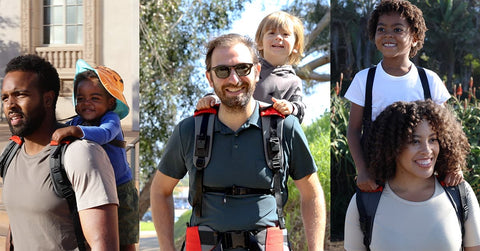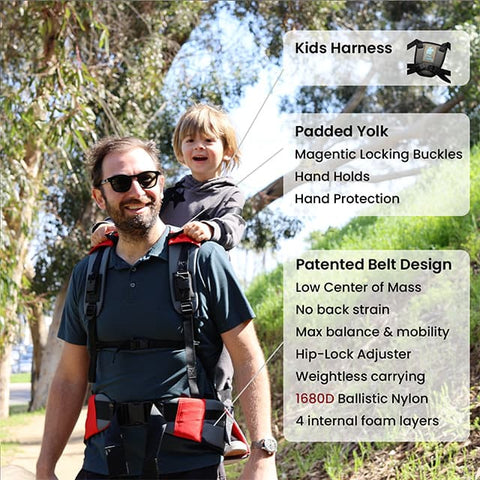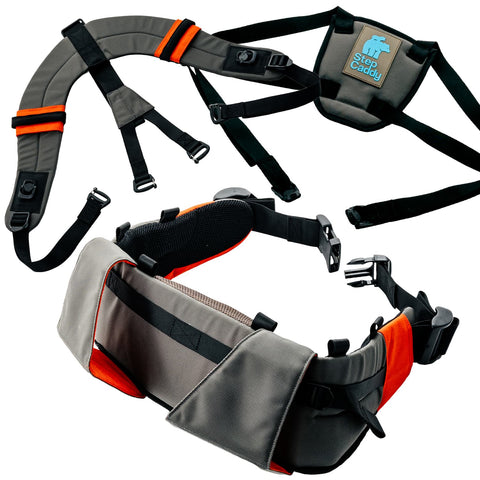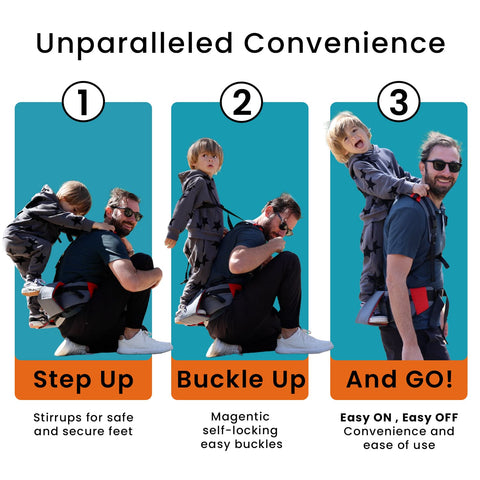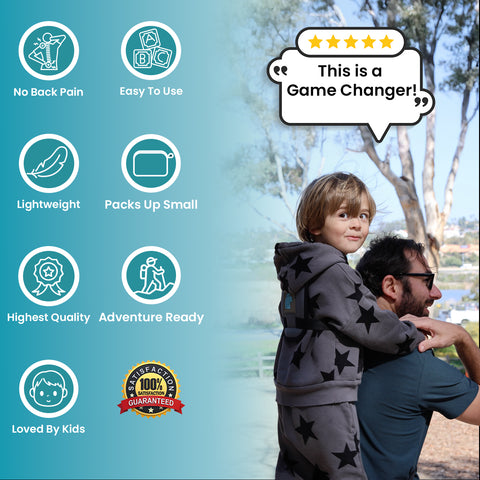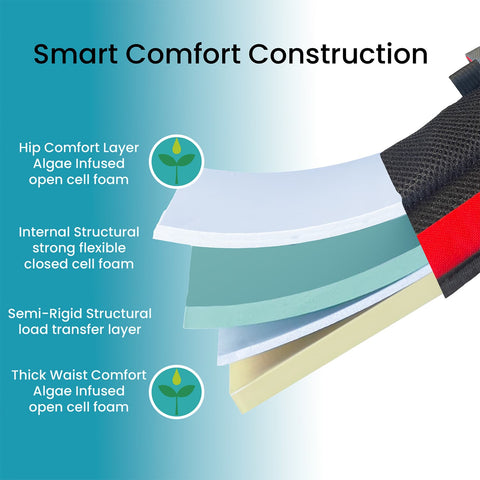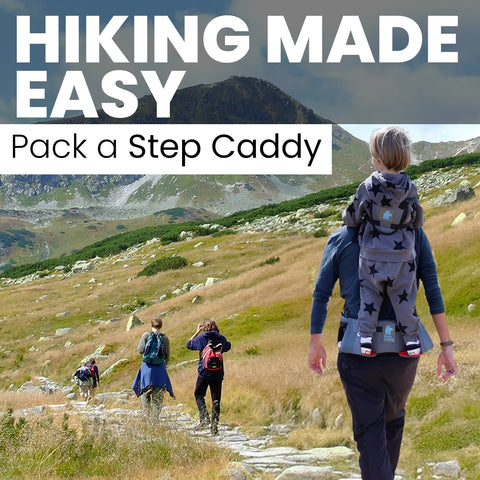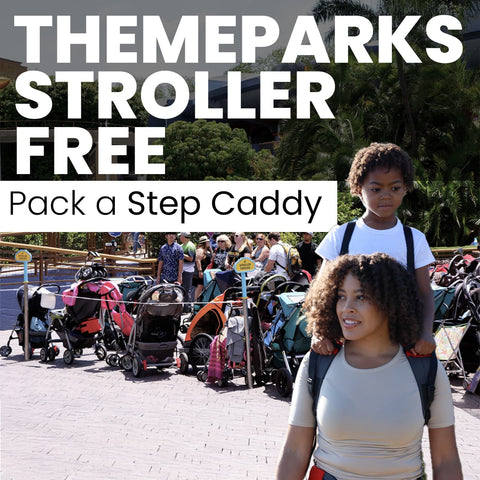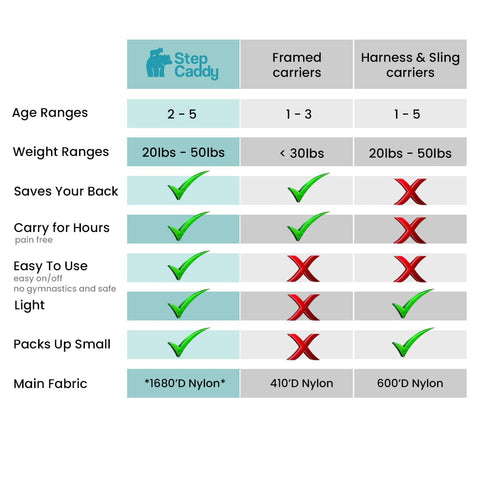A Complete Guide to Choosing the Right Child Carrier
Adventuring with a child aged 4 or 5 can be both incredible and exhausting. Your preschooler is more independent, more mobile, and yes, much heavier. At this age, they’ve typically outgrown the big framed backpack carriers, but they’re not quite ready to power through a full hike or day trip on foot. At some point, every parent of a preschooler faces it: that tired little voice mid-hike or mid-theme park meltdown saying, "Carry me!" And while your child might be brimming with energy, curiosity, and independence, their legs can't always keep up. Welcome to the preschooler paradox: your child is too big and heavy for most carriers, too young for long distances, and too independent for strollers. So, what now?
Let’s talk strategy. Specifically, how to carry your 4-year-old in a way that’s safe, comfortable, and keeps your spine intact. From framed packs to sling carriers to ergonomic marvels like the Step Caddy, we’ll break down the best child carrier options and why your decision matters more than ever at this age.
Why Carrying a 4-Year-Old Is Different
Most carriers are built for infants and young toddlers. At age four, your child likely weighs 35–45 pounds and stands over 40 inches tall. That weight, combined with a higher center of gravity and increased activity, makes most standard carriers a literal pain in the back. Some carriers aimed at larger kids, 4-year-olds and 5-year-olds, are unimaginative larger versions of toddler carriers, that have not accounted for your child's larger dimensions, weight, and activity pattern.
Beyond the physical challenge, 4-year-olds aren’t content to sit for long stretches. They want to walk, explore, and hop back on for a lift when tired. That means your ideal carrier needs to support quick transitions, ergonomic design, and full mobility for both of you. Let's look at three leading categories of child carriers for larger kids, for 4-year-olds:
-
Big Framed Carriers
-
Soft-Structured Carriers (SSCs)
-
Piggyback Carrier - the Step Caddy
The Main Carrier Types (and Their Limits)
1. Framed Backpack Carriers
These are your classic hiking child carriers—rigid, supportive, and often loaded with gear compartments and sunshades. Big-framed child carriers are built like hiking backpacks, with a serious upgrade. They typically feature a rigid aluminum or steel frame that keeps the carrier upright when placed on the ground, making it easier to load and unload your child safely. These carriers often include padded shoulder straps, an adjustable hip belt, and a sternum strap to distribute your child’s weight evenly across your torso and hips. Many come with a built-in sunshade, storage compartments for snacks and gear, and adjustable seating positions to support growing kids. The higher seat position gives your child a clear view of the trail ahead (and behind!), while the structured frame ensures better airflow and stability for both parent and child. Designed for longer hikes, they’re ideal for parents who need robust support over rough terrain. With extra padding and adjustable straps, these carriers securely hold your child while reducing the feeling of weight, allowing for longer and more comfortable hikes. They are great for children up to the age of two, and can be used for children up to three years old, if their energy and activity levels remain low and they don't mind sitting for long periods. Big-framed carriers can be awkward getting into and out of, and are notoriously bulky.
Pros:
-
Great weight distribution for smaller kids
-
High ride gives kids a good view
-
Stable for long hikes
Cons:
-
Bulky and hard to pack
-
Max weight limits often cap out around 40 lbs
-
Require two adults to load and unload safely
-
Preschoolers often outgrow them in height and temperament
Recommendation:
-
KELTY - Journey PerfectFIT™ Elite
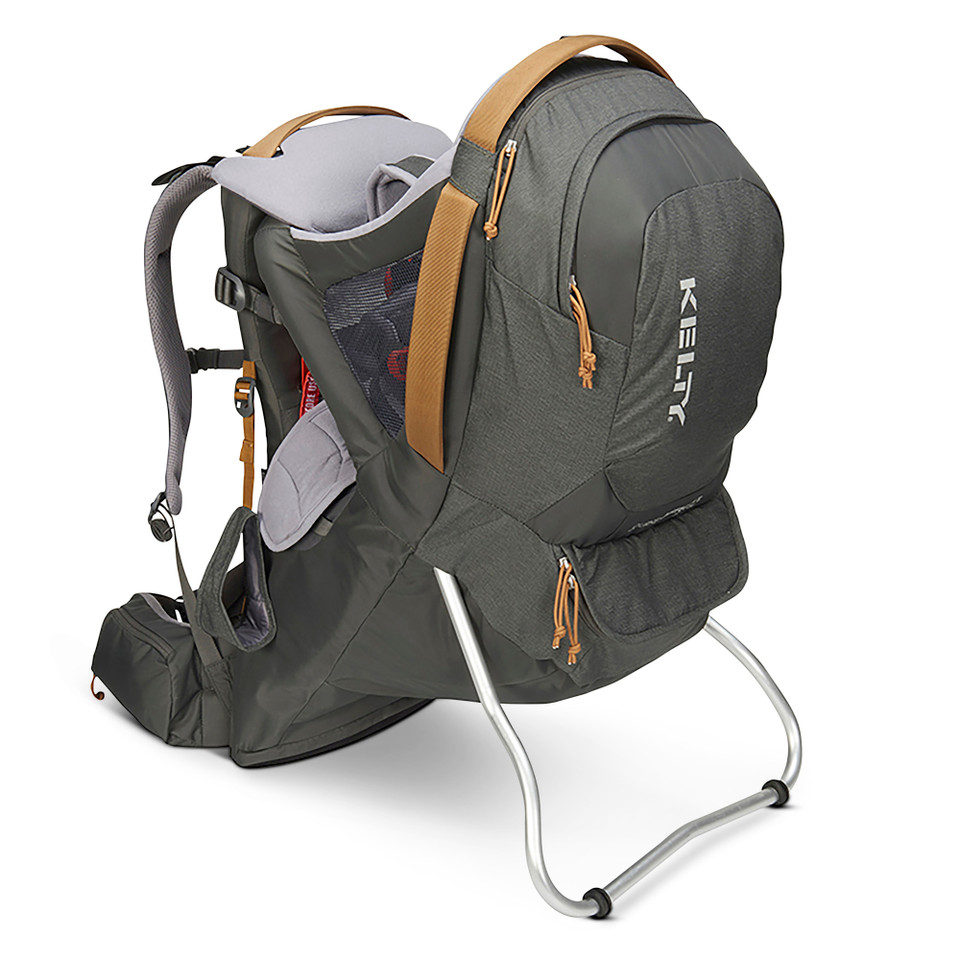
-
For toddlers aged 3 years and under, the Kelti Journey has everything you need in a 'big framed carrier'. It comes with large and small pockets, a sunshade for your little one, and it is very sturdy and comfortable. It is a bit heavy at 7 lbs 4 oz / 3.36 kg, but so are many 'big framed carriers'; this weight is not unusual for this class of child carrier. There is a maximum combined load of 48.5 lbs / 22 kg of child and everything, so as your toddler approaches 30+ lbs, that is something to watch out for. It also has in multiple color options, our favorite is "dark shadow".
-
Price - $350
2. Soft-Structured Carriers (SSCs)
Soft-structured child carriers (SSCs) are the preferred choice for parents seeking comfort, convenience, and a compact design without sacrificing support. Unlike framed carriers, SSCs consist of flexible, padded fabric with a structured waistband and shoulder straps that buckle for a secure fit. While this may make weight distribution away from the shoulders and back less effective, these carriers are designed for younger and lighter children, up to two years of age. Their key advantage is that they are compact and easy to store, making them ideal for everyday use and travel. Most models allow for front, back, and sometimes hip carry positions, providing flexibility as your child grows. They offer ergonomic seating that maintains your child’s hips in a healthy, "M" position, and many feature sleep hoods, storage pockets, and breathable materials for warm weather. Ideal for children from infancy through toddlerhood (2 years old). Without a frame, the carrier does not create an air gap between the parent and the carrier, which can result in uncomfortable perspiration. SSCs achieve a smart balance between freedom of movement and everyday practicality.
Pros:
-
Compact and portable
-
Easy to store and stow
Cons:
-
Poor weight distribution—often dumps weight onto shoulders
-
No rigid support for heavier kids
-
Outgrown quickly by age three
Recommendation:
-
Mama Roo - Lenny Preschool Carrier

-
For toddlers aged 3 years and under, Mama Roo offers lots of different fabric patterns for their child carriers. They boast being able to carry children up to 66 lbs. The carriers have all the advantages and disadvantages of carriers in this class, but Mam Roo offers really nice designs and a great selection of fabric and pattern options.
-
Price: $250 - $337
3. Piggyback Carriers (The Step Caddy)
This innovative style supports older toddlers and preschoolers in a standing piggyback position using built-in stirrups, a secure harness, and a waist-supported frame. Piggyback-style carriers, like the Step Caddy, take a different approach to child transport by embracing your kid’s growing independence while still giving them a lift when needed. These carriers are designed for older toddlers and preschoolers, typically ages 2 to 5, who can walk but tire easily on longer outings. Rather than a full seat, they feature a standing platform or step that supports the child’s weight while securely fastening them with harnesses and handholds. The carrier is compact, lightweight, and equipped with back-saving features like padded shoulder straps and waist belts that shift weight to the hips. The piggyback position offers the greatest convenience of all carriers for ease of mounting and dismounting. With a low weight transfer point and a low center of mass, the Step Caddy particularly provides the best weightless carrying experience. This style of child carrier also offers the best ventilation of all categories and packs down small for easy storage. They’re ideal for theme parks, festivals, hikes, or whenever your “big kid” wants to ride high and stay close without feeling confined. It’s freedom with a fallback plan, fun for them, practical for you.
Pros:
-
Shifts weight to hips (no weight goes on the back)
-
The child can self-board and dismount
-
Ultra-portable and lightweight (under 3 lbs)
-
Built-in stirrups keep the child balanced and engaged
-
A low center of mass and effective load transfer keep the parent mobile and well-balanced.
-
Suitable for kids up to age 5 and 50+ lbs
Cons:
-
Doesn’t work well for children who fall asleep mid-hike (not a reclining seat)
Recommendation:
-
The Step Caddy

-
Price: $195
-
Step Caddy Page: https://stepcaddy.com/
The Weight Distribution Problem
Here’s a harsh truth: most carriers marketed to “big kids” ignore the basic rules of body mechanics. As your child gets larger and heavier, the need for full hip-based load transfer becomes vitally important. Yet most carriers for older toddlers either ditch the waist belt or use a fabric-based sling style that transfers only a fraction of the child's weight to the hips. They rely on your shoulders to carry the load, and that load just transfers down through your spine, leading to aching backs. This is fine for short periods, or if you have a Thor-like physique.
Biomechanically, your hips are your strongest support point. When a carrier moves the weight transfer point to the waist, especially with a low center of mass, it reduces fatigue, improves balance, and saves your spine (read: How Waist Belts in Toddler Carriers Save Your Spine). A well-engineered waistbelt with padding and shaping, like Step Caddy’s Hip Lock Strap, contours the waistbelt to your iliac crest and eliminates pressure points.
When the weight sits too high or too far back (like in many framed carriers), your center of gravity shifts awkwardly. That leads to poor posture, forward hunching, and a whole lot of back pain. Good design fixes that.
What Makes the Step Caddy Ideal for 4-Year-Olds
If there’s one carrier that was designed specifically with preschoolers in mind, it’s the Step Caddy. Here’s why it stands out:
Built-in Load-Bearing Waist Belt
The Step Caddy’s core innovation is its load transfer design. It shifts 100% of your child’s weight directly onto your hips, bypassing your back and shoulders altogether. This makes your child feel "almost weightless," according to users.
Piggyback-Style Positioning
Unlike seat-based carriers, your child stands upright behind you, secured in a harness with magnetic self-locking buckles. The result? Better views, better engagement, and zero passive slouching.
Independent Boarding
No more Olympic lifts or tag-teaming with another adult. Your child steps up, you buckle them in, and off you go.
Foot Stirrups for Balance and Security
These aren’t an afterthought. Built into the waistbelt, they stabilize your child’s footing, prevent swaying, and improve your center of gravity.
Ultra-Light and Packable
Weighing under 3 pounds, the Step Caddy folds to fit in a daypack or carry-on. It’s the only ergonomic carrier for preschoolers that combines structure and portability.
Comparing the Carriers: A Quick Summary
|
Feature
|
Framed Backpack
|
SSC Carrier
|
Step Caddy
|
|---|---|---|---|
|
Weight Limit
|
≤ 30 lbs
|
≤ 40 lbs
|
50+ lbs
|
|
Weight Distribution
|
Primarily Hips
|
Mixed
|
Primarily Hips
|
|
Portability
|
Bulky + Heavy
|
Portable
|
Portable
|
|
Child Mount/Dismount
|
Needs assistance
|
Difficult
|
Easy & Independent
|
|
Child Engagement
|
Medium (high view)
|
None
|
High (standing view)
|
|
Parent Comfort
|
High
|
Low
|
High
|

CONCLUSION: What to Buy
Carrying a 4-year-old isn’t just about transportation—it’s about enabling shared adventure without pain, stress, or tantrums. While traditional carriers served us well when our kids were small, they weren’t built for big kids with big personalities.
-
Weightless Carrying: load-bearing waistbelt with stirrups
-
NO BACK PAIN: weight transfers away from your back and torso
-
Greater Balance and Mobility: low center of mass and load transfer
-
Portable & Packable: designed to fold for a small form factor
-
Ease-of-Use: piggyback means easy-on and easy-off
-
Latest Buckle Technology: magnetic self-locking buckles
-
Latest Toughest Fabrics: 1680D ballistic nylon
-
Speed and convenience that parents need
So go ahead—hike farther, explore longer, and say yes to that magical "Carry me!" moment. With the Step Caddy, it’s not a burden. It’s the beginning of the next great adventure.
Ready to carry your 4-year-old without breaking your back?

